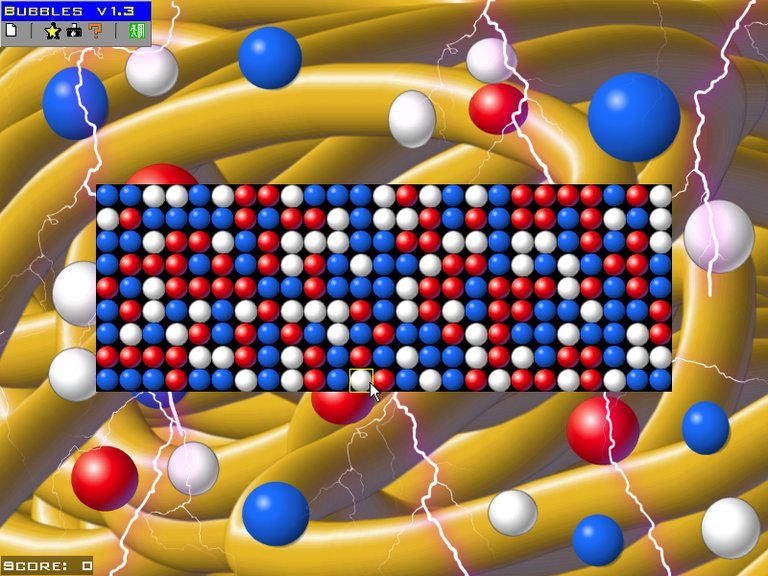- Release Year: 2001
- Platforms: Windows
- Genre: Puzzle
- Perspective: Side view
- Game Mode: Single-player
- Gameplay: Tile matching puzzle
- Average Score: 63/100

Description
Bubbles is a simplistic puzzle game where the player clicks on groups of adjacent bubbles of the same color to remove them from the screen. The game features bubbles in three colors and ends when there are no more removable groups, with the final score calculated at the end.
Where to Buy Bubbles
PC
Patches & Updates
Guides & Walkthroughs
Reviews & Reception
gamefaqs.gamespot.com (80/100): Might be worth a look for fans of early action games, but it’s probably my least favorite of the Williams’ titles that I’ve played.
Bubbles: A Timeless yet Forgotten Gem
Introduction
Bubbles, a puzzle game released in 2001 for Windows, may seem like a simplistic and dated title at first glance. However, upon closer inspection, it reveals itself to be a game with a unique charm and a rich history that spans multiple platforms and decades. This review aims to explore the various facets of Bubbles, from its development history and gameplay mechanics to its reception and legacy.
Development History & Context
The 2001 version of Bubbles was created using the Allegro game development library, a popular choice among indie developers at the time. While the exact development process and team behind this specific version are not well-documented, the game’s simplicity and adherence to basic puzzle game mechanics suggest a straightforward development cycle. The game was released as freeware, making it accessible to a wide audience.
In contrast, the original Bubbles arcade game, developed by Williams Electronics in 1982, had a more complex development history. It was designed by John Kotlarik and Python Anghelo, who aimed to create a non-violent game inspired by Pac-Man. The game’s unique concept and quirky charm set it apart from other titles of its time.
Narrative & Thematic Deep Dive
The 2001 version of Bubbles lacks a traditional narrative, instead focusing on simple, intuitive gameplay mechanics. The game’s objective is to click on groups of bubbles of the same color to remove them from the screen, with the game ending when no more groups are available.
The original arcade version of Bubbles, on the other hand, features a more narrative-driven experience. Players control a soap bubble navigating a kitchen sink, absorbing dirt, ants, and grease while avoiding enemies like brushes, sponges, and razor blades. The game’s quirky premise and colorful graphics add to its charm.
Gameplay Mechanics & Systems
The gameplay mechanics in the 2001 version of Bubbles are straightforward: players must click on adjacent bubbles of the same color to remove them. The game requires strategic thinking and planning to clear the screen efficiently.
In the original arcade version, the gameplay is more complex, with the player controlling a bubble that grows in size as it absorbs objects. The game features a mix of puzzle and action elements, as players must navigate the bubble around enemies and obstacles while trying to clean the sink.
World-Building, Art & Sound
The 2001 version of Bubbles features simple, colorful graphics and basic sound effects. While not particularly noteworthy, the game’s visuals and audio are sufficient to create a pleasant and engaging atmosphere.
The original arcade version of Bubbles boasts more impressive graphics and sound design for its time. The game’s colorful, cartoonish visuals and catchy sound effects contribute to its whimsical charm.
Reception & Legacy
The 2001 version of Bubbles has received limited attention and reviews, with an average score of 2.4 out of 5 on MobyGames. Despite this, the game remains a hidden gem among fans of puzzle games.
The original arcade version of Bubbles, while not a commercial success at the time of its release, has developed a cult following over the years. The game has been included in various arcade compilations and has been praised for its unique gameplay and charm.
Conclusion
Bubbles, in both its 2001 and original arcade versions, is a game that has stood the test of time. While it may not be as widely recognized as other titles, its unique charm and gameplay mechanics make it a worthwhile experience for fans of puzzle and arcade games. The game’s legacy serves as a testament to the creativity and innovation of game developers, even in the face of limited resources and attention.